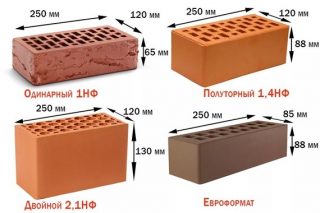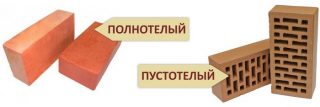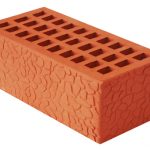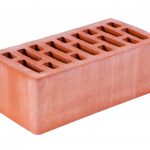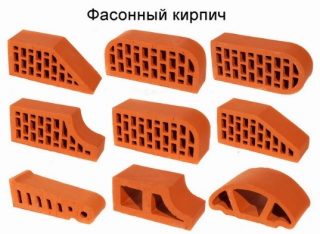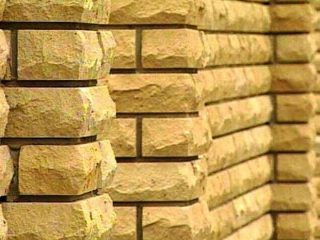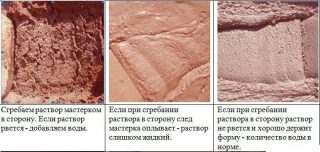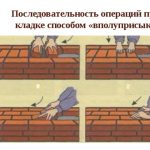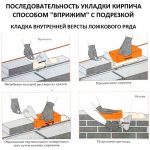One-and-a-half brick is appreciated by builders for its strength and economy, because when laying, you can save cement mortar by almost 2 times, which reduces the cost of the object. Brick is quite expensive, so it is rarely bought to create fences and other secondary buildings.
Characteristics of one and a half brick
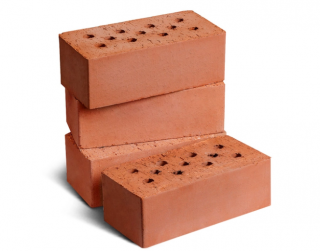
Red one-and-a-half brick produced most often hollow... This reduces the consumption of raw materials and also makes it lighter. During construction, the voids inside are filled with cement mortar with various additives that reduce heat loss. Thus, voids affect the retention of heat in the cold season.
A brick-and-a-half is called so for thickened side walls... It can be used for the construction of load-bearing external and internal walls, for facade cladding.
One and a half building blocks are made from pure clay or from clay with additives to give the material certain qualities.
Yes 2 method for making red bricks:
- Semi-dry pressing method... In this case, bricks are formed from raw clay with 10% moisture by pressing. Such products are not suitable for the construction of premises where high humidity is expected, since the walls will absorb water.
- Plastic. Raw materials with 30% moisture content are pressed and fired at a temperature of 1000 °.
In the second case, it is important to maintain the residence time of the blocks in the furnace, otherwise they will be fragile. In case of overburning and underburning, the brick will be unsuitable for capital construction:
- A light color indicates insufficient firing. Such products are not resistant to temperature extremes, absorb moisture and disintegrate over time.
- If the brick is burnt out, traces of burn marks, cracks and irregularities will be visible on it.... Thermal conductivity values increase, that is, heat will pass through such a brick faster.
When properly processed, the brick has a beautiful color and, when tapped, emits a sonorous sound.
From the raw materials that go to the manufacture of a red one and a half block, you cannot make any other products for construction. In terms of quality and composition, it is not suitable for this.
Differences from single and double
When using one and a half blocks laying time is reduced by 30%... The overall weight of the building will end up being less. These are important points in the construction of two, three and four-story private houses, when a very heavy load is placed on the foundation. The lorry allows you to realize more complex architectural forms without losing strength.
Double bricks also differ only in height. In this version, it is 138 mm. This allows for even faster construction and less weight, as less heavy cement slurry is consumed.
In addition to the three main sizes (single, one and a half and double), you can find on sale custom building blocks: "Euro" 250/85/65 and modular 288/138/65.
Consumption of a single brick is 394 pieces in 1 m³, and one and a half 302 pieces with the same volume.
If you are building a house for a long period (more than 75 years), it is better to choose a material made of baked clay than wood or SIP panels.
Classification and specifications
Depending on the raw material from which the brick is made, distinguish between two types:
- ceramic red;
- silicate white.
They have the same dimensions (both single and one and a half), but the scope, purpose and technical characteristics are different.
Ceramic
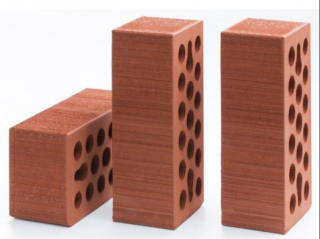
One and a half ceramic brick is a natural building material... If you make the internal partitions and varnish them for safety, the clay will not change its color, it will not fade in the sun.
While keeping the room warm fired clay blocks do not absorb water and do not degrade.
On the market you can find many colors of one and a half bricks... The change in tone is achieved by mixing different types of clay.
Among the shortcomings, we can note the fact that bricks often break during transportation, chips are formed on their lateral sides.
A variety of ceramic blocks are clinker bricks. These are the most expensive products, but at the same time the most durable. They are made from the same raw materials as red ceramic ones, but they are fired at prolonged extremely high temperatures. The clinker is suitable for laying on the floor, garden paths where the load on it will be maximum.
Another variety - cheaper - hyper-pressed brickmade from a mixture of cement and limestone. It is not fired, but pressed under a heavy weight. Externally, the material becomes similar to natural stone. It is strong, but has a high thermal conductivity - when used, it needs additional insulation.

Silicate
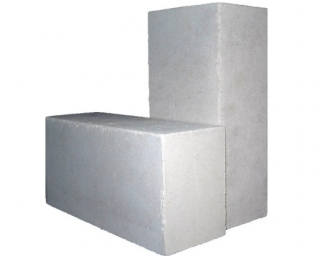
The composition of the silicate brick-one and a half is completely different from the previous ceramic one. Silicates make from well-refined quartz sand and limetherefore the products are white. The components are mixed in a 9: 1 ratio.
Bricks are made from the finished mass by the method of semi-dry pressing and subject them to hot steam under high pressure... The process takes 10-13 hours.
To change the color, natural or synthetic pigments that are resistant to ultraviolet light are added to the mass.
Silicate bricks have the same benefits as ceramic red bricks, but in addition they cheaper by about a third... The weight of one-and-a-half silicate brick depends on whether it is solid or hollow. A solid block can weigh from 4.2 to 5 kg, a hollow lorry weighs from 3.7 to 4.2 kg. For comparison: a single silicate weighs about 3.5 kg, a double hollow from 5 to 5.8 kg.
The indicator of moisture resistance of silicates is lowerthan ceramic products, so they cannot be used to build a foundation, as well as lay out wells, basements, basements, sewer pits and other street buildings from them.
Also silicate products not suitable for the construction of stoves and fireplaces - their heat resistance is lower than that of red bricks. Under the influence of heat and temperature extremes, the stove will crack quickly.
Solid and hollow products
Porosity should not exceed 13%, otherwise the design will be unreliable: when moisture absorbs and freezes inside, and then thaws, the brick crumbles. This indicator is relevant for silicate bricks.
In the hollow varieties of silicates volume of internal holes takes 30%.
In ceramic products, voids can be arranged in different ways and have any shape. In silicate ones, they are displaced towards the center, and the holes are mostly cylindrical.
Scope of application
According to the scope of application, bricks are divided into construction (masonry), facing (front), special, oven, basement.
Products rough designed for the construction of internal walls, fences, filling various voids, self-supporting structures. It can be used for masonry of external walls, but then they must be protected from destruction with plaster.
Facing one-and-a-half bricks are used outside and inside for decorative finishing. Facing products have an even geometry, edges without chips, presentable appearance.
For regions where the climate is more humid, it is recommended to use a red ceramic block, for arid regions, a silicate block is more suitable.
Facing red blocks can be textured and shaped... The first variety has a corrugated uneven surface with an antique effect, uneven sharpened edges. The shaped variety is made in complex geometric shapes with rounded edges. Shaped products are intended for framing windows, doorways, decorative arches indoors, used on the corners of buildings.
The third variety is special blocks... They are distinguished by their refractory qualities. Such products are used for laying out stoves and decorative fireplaces. The material from which the special brick is made is fireclay clay.
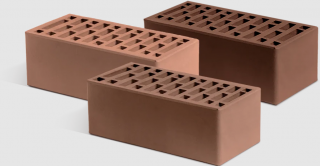
Facing bricks have disadvantages:
- Each batch has a different shade, so it is recommended to calculate the number of pieces well and order them from one batch.
- In the manufacture of products, there is a defect, so you should take with a margin. The products of European manufacturers are of higher quality, there are fewer defective blocks in the batch.
- The cost of facing bricks is quite high, so not everyone can afford to buy this building material.
Hollow cladding ceramic blocks are lightweight because the volume empty space inside is up to 70%.
Stove one and a half bricks must have increased refractory characteristics... It can be ceramic, fireclay, clinker blocks.
blocks are designed to lay out the part of the building located between the foundation and the first floor.
For cladding, you can use cheaper types of bricks - bars.
How to make a one-and-a-half brick masonry correctly
Masonry mortar usually consists of 1 part cement and 4 parts sand, then water is gradually added so that the finished mortar is moderately flowing and does not stick to the trowel.
Consumption of cement-sand mortar at a height of a masonry joint of 1 cm, a third of a cubic meter per 1 m³ of a brick wall is assumed.
Self-laying recommendations brick one and a half blocks:
- All supporting structures are made of solid blocks.
- The lower floors will experience a lot of stress, so they are made reinforced - in 3 - 4 rows.
- Ceramic bricks are laid flat in horizontal rows. Bandaging of vertical and horizontal rows must be performed so that the structure is monolithic.
- Horizontal masonry is controlled with a building level. Vertical - using an attached load. It is recommended to use the order to control the vertical.
- To prevent the solution from spreading, it is laid out at a distance of 10 - 15 mm from the front edge.
When laying rough ceramic blocks, it is used several different technologies - half-filler, half-filler, push-in. Vertical seams are usually filled in the next row as they remain unfilled to the end.
It is recommended for beginners to start laying with a rough brick, then move on to facing.


